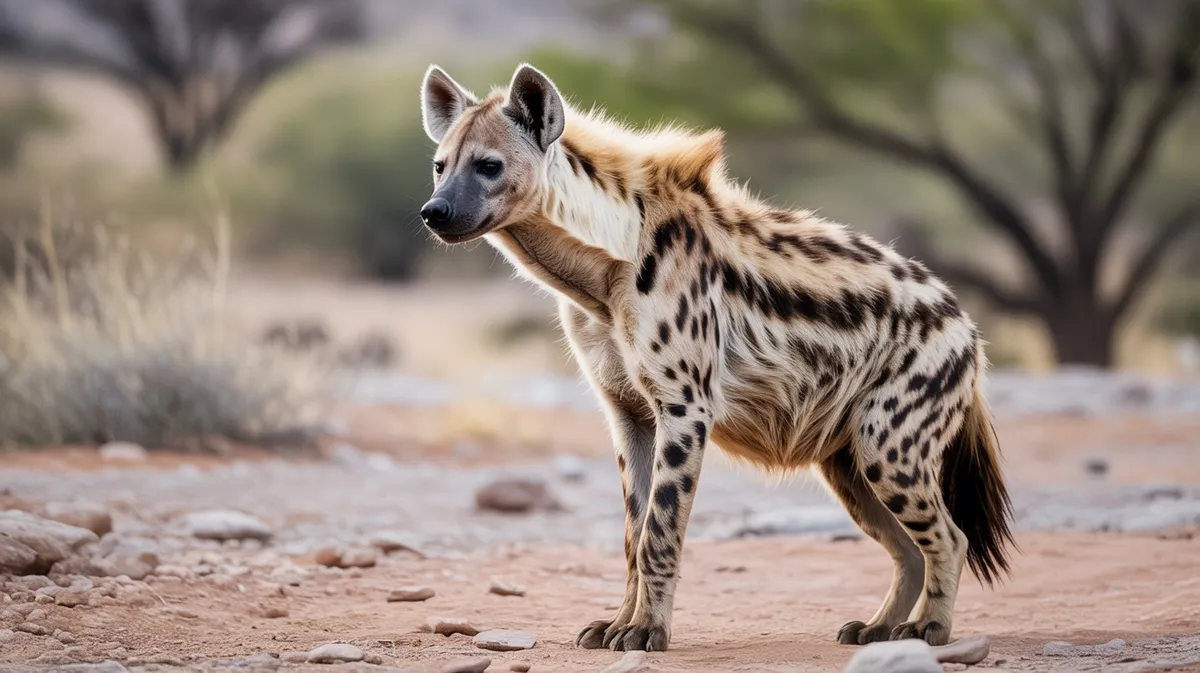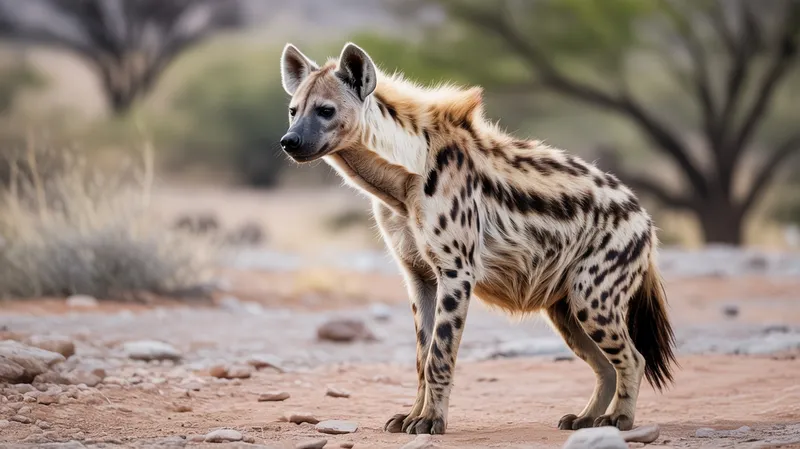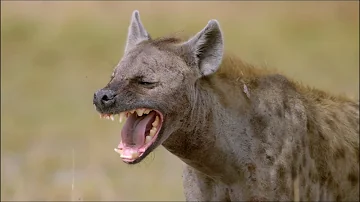
Striped Hyena
Hyaena hyaena

Meet the Striped Hyena
The striped hyena is a medium-sized carnivorous mammal native to North and East Africa, the Middle East, and parts of South and Central Asia. Distinguished by its pale grey or beige coat with bold black stripes on its body, legs, and head, this nocturnal animal is the smallest of the true hyenas. Striped hyenas are mostly solitary or found in small family groups, often scavenging for food such as carrion, bones, and occasionally fruit or insects. Despite their reputation as scavengers, they play a crucial ecological role in cleaning up carcasses and controlling disease spread.
Classification
Mammal
Habitat
Arid and semi-arid regions, scrublands, savannas, grasslands, open forests, and rocky terrain
Diet
Carnivore
Lifespan
10-12 years in the wild, up to 23 years in captivity
Conservation
Near Threatened
Weight
22–55 kg
📖Fascinating Facts
Bone Crushers
Striped hyenas can crush and digest large bones thanks to their powerful jaw muscles and strong teeth.
Nocturnal Lifestyle
They are primarily nocturnal, emerging from their dens only at night to forage or scavenge for food.
Solitary Nature
Unlike spotted hyenas, striped hyenas are mostly solitary or live in small family groups, rarely forming large clans.
📋Detailed Description
The striped hyena (Hyaena hyaena) is a robust, medium-sized carnivore, typically measuring 100–120 cm in body length, with a shoulder height of 66–75 cm and weighing between 22–55 kg, females generally being slightly smaller than males. Its most distinctive features include a shaggy, pale grey to beige coat adorned with pronounced black stripes on the torso, legs, and face, and a conspicuous mane of long hair running from the head to the tail, which can be erected to make the animal appear larger when threatened. The head is large and rounded, with powerful jaws and robust teeth adapted for crushing bones, while the ears are broad and pointed. The forelimbs are longer than the hindlimbs, giving the animal a sloping back profile. Striped hyenas possess well-developed anal glands that secrete a pungent substance used for marking territory. Their eyesight is adapted for nocturnal activity, with large pupils and a reflective tapetum lucidum. They are primarily solitary but may form small family groups, especially during the breeding season or when raising young. The species is highly adaptable, occupying diverse habitats from arid deserts to rocky scrublands and open woodlands, and is capable of traveling long distances in search of food. Striped hyenas are opportunistic feeders, primarily scavenging but also hunting small vertebrates and consuming fruit, insects, and even human refuse where available. Their ecological role as scavengers is crucial for nutrient cycling and disease control in their ecosystems.
💡 Did you know?
In some cultures, striped hyenas have been tamed and used as beasts of burden or to help guard livestock.
🔬Research & Sources
Wikipedia Summary
The striped hyena is a species of hyena native to North and East Africa, the Middle East, the Caucasus, Central Asia, and the Indian subcontinent. It is the only extant species in the genus Hyaena. It is listed by the IUCN as near-threatened, as the global population is estimated to be under 10,000 mature individuals which continues to experience deliberate and incidental persecution along with a decrease in its prey base such that it may come close to meeting a continuing decline of 10% over the next three generations.
Last Modified: 5/30/2025
🎭Behavior & Social Structure
Striped hyenas are strictly nocturnal, emerging at dusk to forage and returning to dens before sunrise. Their home ranges can span 20–40 km², with individuals covering up to 30 km in a single night. They rely heavily on olfactory cues for navigation and locating food. Feeding behavior is predominantly scavenging, with a remarkable ability to crush and digest bones due to their powerful jaws and highly acidic stomachs. While generally solitary, they may tolerate conspecifics at abundant food sources or during the breeding season. Social interactions are subtle, involving scent marking, vocalizations (such as whoops, growls, and giggles), and body postures. Striped hyenas are known to cache surplus food and may return to large carcasses over several nights. They are cautious and secretive, avoiding human contact and larger predators, but can be bold when defending dens or offspring. Dens are typically located in caves, crevices, or abandoned burrows, providing shelter and protection.
👶Reproduction & Life Cycle
Striped hyenas are monogamous, with pairs maintaining overlapping territories. Breeding can occur year-round but often peaks in late winter to early spring, depending on local conditions. After a gestation period of approximately 90–92 days, females give birth to 2–4 cubs (rarely up to 6) in secluded dens. Cubs are born blind and helpless, weighing about 750–900 grams, and their eyes open after 7–9 days. Both parents participate in rearing, with the female providing most of the direct care, including nursing for up to 8 weeks. The male may assist by bringing food to the den. Cubs begin to consume solid food at 30–35 days and are weaned by 3–4 months. Juveniles remain with the mother for up to a year, gradually learning to forage and scavenge independently. Sexual maturity is reached at 2–3 years of age.
🛡️Adaptations & Survival
Striped hyenas exhibit several adaptations for scavenging and survival in harsh environments. Their powerful jaws and specialized dentition allow them to crush large bones and access marrow, a nutrient-rich food source unavailable to many other carnivores. Their digestive system is highly acidic, enabling them to process decaying flesh and bone with minimal risk of disease. The long mane can be erected to intimidate rivals or predators. Acute senses of smell and hearing aid in locating carrion over vast distances, while cryptic coloration provides camouflage in rocky and arid landscapes. Behavioral flexibility, including omnivorous feeding and opportunistic scavenging, allows them to exploit a wide range of food sources. Their ability to subsist on minimal water and tolerate high temperatures is crucial for survival in arid habitats.
🎨Cultural Significance
Striped hyenas have a complex relationship with human cultures across their range. In ancient Egypt, they were depicted in tomb art and sometimes tamed or semi-domesticated. In Middle Eastern and South Asian folklore, hyenas are often associated with witchcraft, grave-robbing, or as omens of misfortune, leading to widespread superstition and persecution. Conversely, some cultures regard them as cleaners of the environment, recognizing their role in consuming carrion. Body parts such as hair, bones, and fat are used in traditional medicine and rituals in parts of Africa and Asia. Despite negative perceptions, their ecological importance is increasingly recognized in conservation education programs.
🔬Recent Research & Discoveries
Recent research has focused on the striped hyena's role as a keystone scavenger, revealing its importance in nutrient cycling and disease suppression. Genetic studies have clarified its evolutionary relationships, confirming it as the only extant member of the genus Hyaena and highlighting low genetic diversity in some populations. Camera trap surveys and GPS telemetry have improved understanding of home range size, habitat use, and movement patterns, informing conservation strategies. Studies on human-hyena conflict have led to community-based mitigation efforts in several countries. Ongoing research is investigating the species' adaptability to urban environments and the impact of climate change on its distribution.
🎥Wildlife Videos

Striped Hyena: 4K ULTRA- HD - Nature's Mysterious Marauder!. Habitat, Prey, Adaptations, Competitors
The enigmatic striped hyena, with its distinctive, well, stripes, is a creature of wonder and fascination. These creatures are found in ...
Wildlife Serenity

Striped Hyena | Animated | Wildlife Documentary | Informative #biography#wildbirds#seaanimals#nature
Striped Hyena | Animated | Wildlife Documentary | Informative #biography#wildbird#seaanimals ...
Animals World.official

Hyenas - The most effective predators in the African savannah
Hyenas - they are clever, caring and have a pronounced social intelligence, clever beasts, so to speak. This makes them so ...
Free High-Quality Documentaries

Striped Hyenas of Bhigwan | Rare Wildlife Encounter in Maharashtra
Join us on a rare and unforgettable journey into the lesser-known wilds of Bhigwan, Maharashtra, where we witness the elusive ...
Joy Amed Adventure

Wild Life - Spotted Hyenas Documentary 2020 Full HD 1080p
Hyenas hunting Wiildebeests and stealing for survival. National Geographic Documentary 2020 Full HD 1080p. Wild Life Check ...
WildLife Tales

Striped Hyenas: Africa's Stealthy Scavenger
"Striped Hyenas: Africa's Stealthy Scavenger" The striped hyena, scientifically known as Hyaena hyaena, is a medium-sized ...
Familiarity With Animals (FWA)
🌍Habitat Information
The Striped Hyena typically inhabits Arid and semi-arid regions, scrublands, savannas, grasslands, open forests, and rocky terrain environments. Striped Hyenas have adapted to their environments with specialized features and behaviors.
Primary Habitat:
Arid and semi-arid regions, scrublands, savannas, grasslands, open forests, and rocky terrain
More detailed habitat information will be available soon.
🛡️Conservation Status
The Striped Hyena is currently classified as Near Threatened. Conservation efforts are crucial for preserving this species for future generations.
Common Threats:
- 🏠Habitat loss and fragmentation
- 🌡️Climate change impacts
- 🎯Hunting and poaching
- 🏭Human-wildlife conflict
⚠️Threats & Conservation Challenges
Major threats to striped hyenas include habitat loss and fragmentation due to agricultural expansion, urbanization, and infrastructure development. Deliberate persecution is common, as hyenas are often blamed for livestock predation or are killed for body parts used in traditional medicine. Accidental poisoning, road mortality, and depletion of natural prey due to overhunting also contribute to population declines. The global population is estimated at fewer than 10,000 mature individuals, with a continuing downward trend. Conservation challenges include a lack of public awareness, insufficient legal protection in some regions, and difficulties in monitoring populations due to the species' elusive nature. Human-wildlife conflict remains a significant issue, particularly in areas where hyenas scavenge on livestock carcasses or human refuse.
🔬Scientific Classification
Scientific Name
Hyaena hyaena
Classification Hierarchy
🔍 About Taxonomic Classification
Taxonomic classification is a hierarchical system used by scientists to classify and organize living organisms based on shared characteristics and evolutionary relationships.
The system moves from broad categories (Kingdom) to increasingly specific ones, with each animal's scientific name typically consisting of its Genus and species.
📝Community Notes
Share your observations and insights about the Striped Hyena with our community of wildlife enthusiasts.
Join Our Community
Sign in to share your observations and connect with fellow wildlife enthusiasts.
Sign In to ContributeNo community notes yet
Be the first to share your observations about the Striped Hyena!
Explore Striped Hyena
Select a tab above to learn more about this amazing animal.
📸Photo Gallery
No photos available for this animal yet.
🌟Discover More Wildlife
Continue your journey of discovery with more fascinating animals from our database
